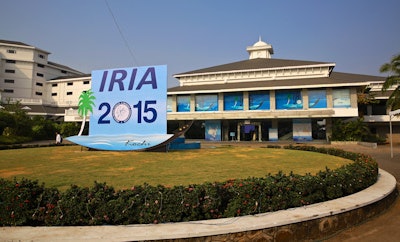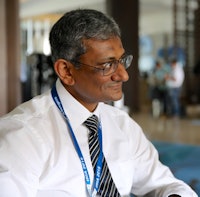
KOCHI, INDIA - Two things are immediately striking about a radiology meeting in India. The first is the sheer opulence of the evening banquets, which are included in the registration. This puts the meager culinary offerings of meetings in the U.S. and Europe to shame.
The second is the technology. One might expect technology to lag a bit in a country with little social or private insurance, where patients are responsible for the entire payment for their scans. Yet GE Healthcare showcases its latest CT scanner here. There is little temporal discordance between technology shown at the annual RSNA meeting and what was displayed at the Indian Radiological and Imaging Association (IRIA) meeting, which was held January 29 to February 1 in Kochi.
 The meeting hall for IRIA 2015 in Kochi. Photo by Dr. Woojin Kim.
The meeting hall for IRIA 2015 in Kochi. Photo by Dr. Woojin Kim.I spoke with Dr. Bhavin Jankharia, one of India's leading radiologists and former president of the IRIA. Bhavin is the CEO of Jankharia Imaging, a private medical imaging group in Mumbai. A noted early adopter of technology, as well as an educator, writer, and administrator, Bhavin wears many hats. His group was the first to use 64-detector-row CT in Asia, beating the Chinese by two hours.
Jha: What has been the motivation for Indian radiology practices to adopt the latest CT and MRI technology? Standard economic theory predicts that when patients are paying out of pocket and they're not aware of quality, there will be a race to the bottom with competitors outbidding each other on price. This has clearly not happened in India.
Jankharia: First, you shouldn't discount standard economic theory totally. India has many faces and is not a monolith. So some of what is predicted does happen. But to show that you have a cutting-edge practice, one component -- and I stress, just one component -- is the technology you have.
Jha: To show whom? The patient? The patient surely doesn't know the incremental benefits of dual-source CT technology over single-source CT.
Jankharia: True. But we appeal to the referring clinicians. If they do not trust us, we will not get their business.
 Dr. Bhavin Jankharia. Photo by Dr. Woojin Kim.
Dr. Bhavin Jankharia. Photo by Dr. Woojin Kim.Jha: But how can clinicians, with little technical knowledge, judge the advantage of a 3-tesla magnet over a 1.5-tesla magnet? Do they see the images?
Jankharia: They don't necessarily see the images. But they believe that a practice that has a 3-tesla magnet has the "latest" technology and must be good. Technology instills trust. They can then say to the patient, "You should have your MRI of the brain done at Jankharia Imaging because they have the latest equipment." For the patient, it is important to know that you have the latest equipment, and you are not the sort that is trying to skim profits on old machines.
Jha: So does technology signal quality?
Jankharia: It is more an enabler of trust than a marker of quality. Soon 3-tesla MRI becomes a sort of household term, even though no one really understands the physics behind it.
Jha: When you buy new technology, do you raise the price of the services?
Jankharia: Well, you can do that, but within a limit. I can't charge twice as much for [scans on] a higher-end magnet, because then patients won't come to my center.
Jha: There is still sensitivity to price.
Jankharia: Yes, within a limit. Quality can't be delivered at any price. But quality is valuable.
Jha: Since patients pay out of pocket, do they shop around for the best price and best quality? Do they ask whether a study is indicated?
Jankharia: Not really. Patients trust the clinicians. They have to. There is so much of a knowledge gap. Some have one or two questions. But by and large they do not question the indication of the study. If they do want to shop and want a better price, they often just ask the referring clinician directly to refer them to a place that fits their budget.
Jha: How do clinicians judge the quality of a radiologist?
Jankharia: The main thing is that you have to help them out and not make matters worse. This is particularly so with complex cases. Let's say a patient with hemoptysis is sent to you, and you miss an arteriovenous fistula that is picked up a month later by someone else. Then the clinician will look bad in front of the patient and will wonder about the skills of the radiologist. On the other hand, if you nail a diagnosis, it is the clinician who looks good with the patient, and he or she will send more referrals your way. You are judged on the most complex cases. We are truly the doctor's doctor here.
Jha: Clinicians actually read your reports!
 Dr. Saurabh Jha.
Dr. Saurabh Jha.
Jankharia: Of course! Do they not do so in the U.S.?
Jha: Do you hedge in the reports?
Jankharia: By hedging do you mean giving a differential diagnosis? If so, yes.
Jha: Do you say, "Malignancy or PE [pulmonary embolism] can't be ruled out with absolute certainty"?
Jankharia: Not so much. But PE is either there or not there. There is little "maybe."
Jha: Do clinicians judge you by the turnaround time of your reports?
Jankharia: To some extent, report turnaround and access are important. That is, we can't take days to issue reports or weeks to give patients their appointments. But we are not judged by minutes -- there is no one watching whether we issue a report in two hours or in 20 minutes. Bear in mind that I work in outpatient imaging. Things might be different for radiologists in hospitals.
Jha: Your center was the first to use 64-detector-row CT in Asia. You were an early adopter of cardiac CT and cardiac MRI. Who were your first patients? Did you cater to a high-end market?
Jankharia: I am not sure what you mean by high end?
Jha: Were your first customers from Bollywood?
Jankharia: There is more to Mumbai than Bollywood! Our customer base -- indeed, the customer base for medical imaging in India -- is the middle class. If we relied on the richest, imaging would not grow. We wouldn't have enough patients. And to be blunt, sickness and income follow an inverse curve.
Jha: Is the adoption of imaging technology changing in India?
Jankharia: It is. The return on new technology is reducing. Technology is approaching a plateau. There are very few game changers these days. We needed 64-detector-row CT to make the big leap to cardiac CT and vascular CT angiography. But the difference between 256-detector-row CT and 320-detector-row CT is minimal.
Jha: Who is buying the new machines?
Jankharia: Let me backtrack a bit. The first wave of adoption was by private-practice radiologists. By that I mean those who owned their equipment. We led the way with adoption of 64-detector-row CT, 3-tesla MRI, the latest cardiac CT and MRI, brain perfusion, etc. Two things have happened simultaneously. First, newer technology is offering less and less in terms of added clinical benefits. Second, having the latest technology for the sake of "newness" matters less and less.
Jha: The law of diminishing returns.
Jankharia: Yes. We needed the newest technology to establish our share of the market. But now a lot of private radiologists are well-established with their market share, and newer technology is unlikely to give them as much edge as it did 10 years ago. The market is saturating and technology is approaching a plateau.
Jha: The market has segmented. You have fiefdoms.
Jankharia: Not fiefdoms exactly, but a community comprised of referring physicians and radiologists. Now it is the hospitals that are buying the latest equipment. They are doing so because it enhances their brand.
Jha: So PET/MRI is unlikely to penetrate the private-practice market?
Jankharia: I don't think it has value for the money. We have PET/CT which is doing a lot of business. PET/CT was a game changer. PET/MRI is not. Although if the price drops substantially, I might reconsider.
Jha: Essentially, the hospitals are behaving the same way private entrepreneurs did 10 years ago.
Jankharia: Yes, and not just in terms of adopting technology. Newly qualified radiologists are more likely to work in hospitals than private practice. The thirst for being an entrepreneur is diminishing. The new generation is lifestyle-conscious. There is reward in owning your own equipment, but it involves a lot of work -- you are working around the clock. The hospitals pay them handsomely, at least enough to have a decent work-life balance.
Jha: In other words, hospitals are consolidating faster than independent ownership of equipment is growing.
Jankharia: Exactly. And this trend will be difficult to reverse.
Jha: What are the vendors actually selling?
Jankharia: There is a market for replacement technology. Radiologists will try to use the equipment for as long as they can. There is also a market for upgradable technology, sort of the 1.5-tesla magnet that can be upgraded to 3 tesla.
Jha: Have you started CT lung cancer screening?
Jankharia: We will do so soon. We have established a group comprised of radiologists and chest physicians.
Jha: Will you follow National Lung Screening Trial (NLST) criteria?
Jankharia: Not strictly. We will relax the age requirement and the pack-years, as there is some evidence of individual benefit in smokers who do not meet the NLST criteria.
Jha: Will patients pay out of pocket?
Jankharia: Of course. There are no mass screening programs in India, not for breast cancer, not for tuberculosis, and certainly not for lung cancer.
Jha: Did you respond to the U.S. Food and Drug Administration (FDA) warning for nephrogenic systemic fibrosis (NSF)?
Jankharia: Yes, we counseled patients with low glomerular filtration rate (GFR) about the risk of NSF and, over time, changed our contrast agent.
Jha: Why? I mean there were no reported cases of NSF in India. You don't have an FDA looming over your shoulders, nor trial attorneys and class-action lawsuits.
Jankharia: Well, if the literature and a regulatory agency in the U.S. say something is harmful, we can hardly ignore that.
Jha: Do you defer to evidence-based literature from U.S. and European publications?
Jankharia: Very much so. We do not have a robust, independent, evidence-based tradition in India presently.
Jha: What is the single biggest challenge for radiology in India?
Jankharia: There are several challenges. The biggest challenge is an ethical challenge: referral fees.
Jha: Can you explain "referral fees"?
Jankharia: Clinicians get a cut for referring patients to the center.
Jha: Do you mean kickback? That's illegal in the U.S. There are strict antikickback laws.
Jankharia: Yes, I mean kickback. In India it's unethical but not illegal. It is a problem because it reduces public trust in physicians. The media have led sting operations to reveal it.
Jha: Why is it so difficult to solve?
Jankharia: Because nearly everyone is involved. This has become a social norm. That is why it's difficult to solve. Because when you tell one person to change, they will point at 100 others who are doing the same thing. Nevertheless, many regulatory agencies like the Maharashtra Medical Council (MMC) and the Medical Council of India (MCI) have also started the process of trying to clean up, along with many local groups of doctors working together cohesively in select cities and states.
Jha: What's the cut?
Jankharia: Anything from 20% to 50%.
Jha: Not exactly chump change. But then again, you don't have insurance or other middle men.
Jankharia: It doesn't look good. It makes us look like car salesmen. Doctors do not adequately self-regulate.
Jha: The other side to having no antikickback law is that you have price transparency. In the U.S., people hide behind this statute as an excuse for high and wild price variations.
Jankharia: We have complete price transparency -- i.e., we reveal our prices. Our prices do not go out of control. It's not like MD Anderson Cancer Center, where you can be charged $4,000 for an abdominal CT. $4,000 for a CT! Come on, there is no justification for that whatsoever!
Jha: I agree. Different countries. Different systems. Unique warts. Unique benefits. Tell me, what's the best thing about being a radiologist in India?
Jankharia: Let me answer the question differently. The best thing about being a radiologist and entrepreneur, owning your own equipment, is autonomy. I do not have to answer to Indian Institutes of Technology - Indian Institutes of Management (IIT-IIM) administrators, who think only in terms of productivity, return on investment, return on capital employed, turnaround times, and other jargon-related indices, often disregarding the potential adverse effect or improved benefit to patients. When I see that technology offers genuine benefit within a reasonable price, it's my decision whether to adopt or not.
Dr. Saurabh Jha is an assistant professor of radiology at the Hospital of the University of Pennsylvania. He is a superspecialized cardiovascular imager but will grudgingly admit that he is really just a general radiologist who likes the heart more than the posterior fossa.
The comments and observations expressed herein are those of the author and do not necessarily reflect the opinions of AuntMinnie.com.




















